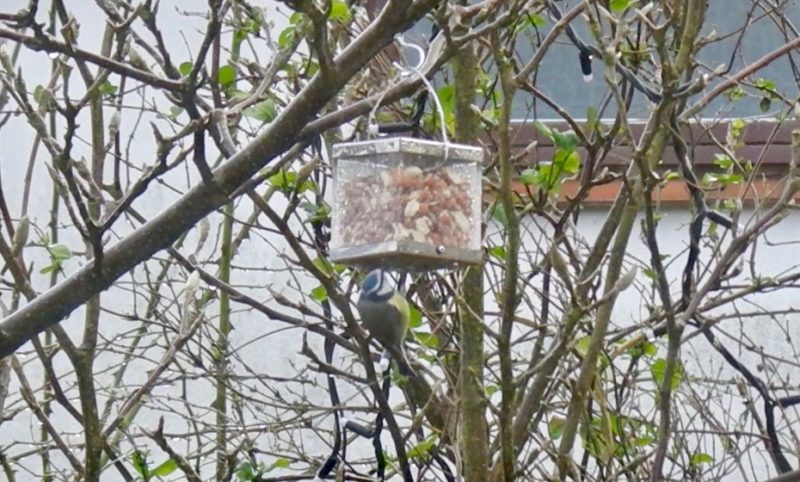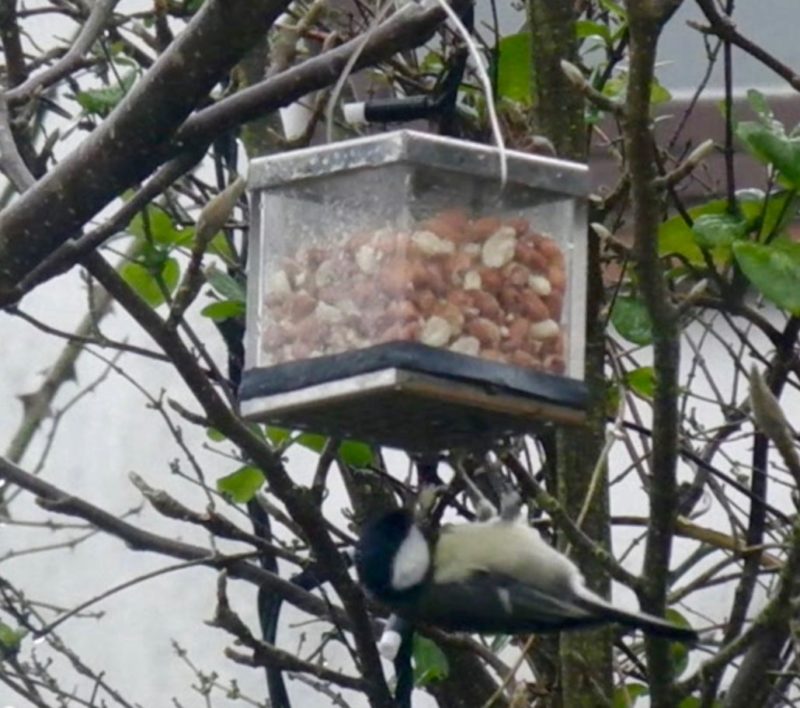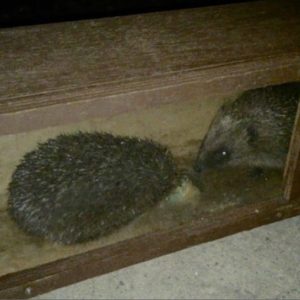Description
introducing the Nurturing Nature Peanut Feeder
Nowadays many bird feeders have been designed to attract a wide variety of species and numerous birds that visit your garden. Recent research by the BTO and University of Exeter 2018 found that bird feeders may only be feeding the larger birds that fight their way to the feeder. Such birds as House Sparrows and Greenfinches monopolised the food, spent longer feeding and dominated the higher value foods, leaving the lower value food for the smaller birds. They found that Blue and Coal tits spent less time feeding and this was on the lower value foods.
Searching for food
Many garden birds use a mix of multiple feeding strategies, depending on the availability of different foods, access to the food and opportunities that arise at that moment in time, e.g. searching for autumn berries, spring caterpillars or bird feeders.

Blue Tit feeding on Nurturing Nature Peanut feeder
Gleaning upside down
Perrin states that ‘Blue Tits, Cyanistes caeruleus concentrate their foraging efforts in the outer twigs and branches of the trees’. Stenning states they, ‘may be the most gymnastic of arboreal passerines, and, like many species of tits, are particularly adept at hanging upside down and performing complex foraging manoeuvres, some of which may be unique to the genus’. Being agile, allows the gleaning of the undersides of branches, twigs, buds, leaves,etc., in their search for food. With their small pointed beaks, these birds are well suited to pluck individual prey items from the underside of foliage and leaves for caterpillars, aphids, etc. You may have seen this behaviour as both Blue Tits and the larger, less agile Great Tits, Parus major, look for prey items underneath roofs and gutters, especially when hunting for spiders.
Inquisitive tit species
Blue Tits are known to have an inquisitive nature and can be counted on to be one of the first species to explore a new garden feeder. Perrin states,” Tits are perpetually inquisitive and frequently investigate strange objects.” Indeed they are credited with opening milk bottle tops to eat the cream!
Some years ago I read an article by the BTO which mentioned that possibly because of changes in bird feeding and feeders, their Garden Bird Feeding Survey had found a fall in Blue Tit numbers recorded actually using supplementary foods in gardens.
It made sense to me, as I often see Blue Tits chased away from bird feeders and tables by other birds, although the Blue Tits still visited and often nest in my garden and I know actual numbers fluctuate year on year with numbers affected by poor breeding success for example. This got me thinking. Could a feeder be designed that would allow Blue Tits to feed in peace and that most other birds could not use and thereby not chase them away?
Great tits
You can see a Great Tit feeding in the video from the peanut feeder. Being the largest and heaviest member of the tit family, the Great Tit is less agile and spends a lot more time, except when feeding nestlings, foraging and feeding on the ground, often seen when the beech mast has fallen in autumn. However, I shouldn’t have been surprised it was using it, “Many authors have commented on the Great Tits’ intelligence, the species showing a high degree of flexibility in its behaviour and an ability to learn tasks”. Although as rightly pointed out by Mettke-Hofmann (pers. comm) ” It is more likely linked to personality – individuals differ consistently in their responses to environmental challenges. Explorative individuals are also often bolder in dangerous situations and more aggressive. The term personality originates from human research but it has been shown that basically, every organism from birds to ants shows personality”. (See refs. below)
Perrin states that “In winter Great Tits spend a high proportion of their feeding on the ground”. “It is most commonly found searching for food on the medium to large branches and the trunks or boles of the tree. It often searches the lower trunk from the ground and, flies up to catch whatever it may see”. This intelligent tactic came in handy for the individual Great Tit on the feeder!
Nurturing Nature Peanut Feeder
Stenning states “Blue Tits are not well adapted to movement on the ground”. The design takes advantage of their inquisitive tendencies, feeding behaviour, incredibly powerful grip, manoeuvrability, and tendency to feed or glean whilst hanging upside-down. These abilities make it difficult for many other birds to have access to the food within the feeder. Although agile and also naturally cling upside-down in their search for food, Coal Tits, Long-tailed Tits and Siskins, are infrequent visitors to my garden. You may be lucky if they visit your garden and they may also learn to use this feeder over time. Let me know if they do! It would make an interesting exercise to see if dominant birds which are not able to feed on the feeder would chase away other birds that could. Would it be worth the effort of defending?
Feeder colour
Recent research with the primary aim to investigate the effect of feeder colour on the feeding preferences of wild birds found that both Blue and Great Tits preferred feeding on transparent feeders with silver lids, although humans preferred other colours when selecting feeders from garden centres with silver way down the preference scale!
‘Peck and go’ at feeders or tables
Have you noticed how the Blue Tit, in particular, is chased away from garden bird feeders by larger birds and flocks of birds? They appear to be way down the ‘pecking order.’ When using garden feeders or tables, I have seen, on most occasions, many Blue and Great Tits using a foraging technique similar to a ‘food to go’ or to be more precise a ‘peck and go’, tactic. Whereby they either grab a food item from a bird feeder/table or peck at it and carry the food item in their beaks to a relative place of safety and cover to eat often using the ‘hold-hammering’ technique. Once eaten, they may return and do it again. Only on a few rare occasions did an individual Blue or Great Tit stay longer to feed on bird feeders or tables. They were usually alone and often juveniles. I have always assumed that these birds are particularly hungry as they quickly process each food item at the feeder and start on the next one. This may well not be the case though!
Caching (Hoarding)
I have often watched Coal Tits who also have a ‘peck and go’ tactic, though being food hoarders they may not eat it immediately and may cache it for a rainy day. Hopefully out of sight of Great and Blue Tits who will steal the food! I have watched a Coal Tit cache a food item from a feeder and within seconds a Blue Tit will find it, eat it or occasionally simply drop it onto the floor!

Hmm! This looks interesting.
Unlike the Blue Tits, I note that for example in my garden, Finches and Starlings stay for much longer feeding bouts on feeders or tables, especially when part of a flock, in what could be described as ‘binge-eating’.
Neophobia and neophilia
I have over the years wondered why birds are cautious of using a new feeder even though it may contain and they can see a familiar food item inside it. Thanks to Greenberg, I have now grasped it! Neophobia is the aversion that an animal displays towards approaching a food item, object, or place simply because it is novel. Whereas neophilia is the spontaneous attraction of an animal to a food item, object or place because it is novel. Different species and even different individuals will have different responses to the stimuli.
Checking out a new feeder or food
Tryanowski states, that when presented with novel stimuli, birds can respond in at least one of three ways: with interest, (neophilia) fear (neophobia) or indifference. You may have found this yourself when presenting a new food e.g. nyger seeds, or a new feeder. I have found Blue Tits in particular certainly are amongst the first birds that will explore a new feeder!
Why check out a new feeder?
Exploring a new feeder and its location incurs costs to a bird such as time and energy and may not produce an immediate payoff. There is also a risk that an unknown object may harbour an unknown predator or an unknown food may be poisonous.
Predation at feeders
Birds are creatures of habit and very cautious. They have to be with predators around and investigating where any potential threats and escape routes there are around the feeder will have to be investigated. Whilst feeding on artificial feeders, birds are especially vulnerable due to a lack of good sightlines or cover. Their ability to avoid predation is rather high on their list!
Dominance at feeders
They also have to be aware of dominant birds within their species, who are naturally more aggressive and protective towards their feeding areas. Then, of course, there are other dominant birds which may be larger or simply more aggressive than the birds feeding at the feeder, and chase them away. Or a large flock of birds lands to feed at the feeder, e.g. Starlings. There is a lot more to bird feeding than we think!
How do birds learn to use the new feeder?
I think this video shows how they do it for this particular feeder. The Blue Tits, in particular, are displaying exploratory behaviour, firstly around the feeder and then on it. This consisted of flying past it, landing near it and looking at it, landing on the roof, landing on the sides, viewing it from underneath, and flying underneath it, probably to build up their confidence before they started to feed. I found not one bird fed immediately when it was positioned. It can take several days for them to use it as they slowly build their confidence. Although a test case in Scotland reported after putting the feeder up, a few exploratory flights near it by Blue Tits and then just 27 minutes later started a Blue Tit was seen feeding on it! Now they are making an orderly queue, one feeds whilst another waits its turn nearby!
Longer feeding bouts
Once they get used to it, they will return and individual Blue Tits, feed for much longer periods than a ‘peck and go’ feeding strategy, as shown in the video. Have patience! Gibb states “ In general, the bolder, dominant and more inquisitive individuals, which were the first to find freshly introduced foods, for instance, settled down more readily than timid, submissive (and ? less intelligent ) ones.” Implying perhaps the more intelligent birds were the first to find new foods. Besides, the Blue Tit you see in your garden may well be one of many that visit it! Stenning confirms this by saying that they can be broadly divided into natives, residents, immigrants and floaters.
Instructions
As with all of the products I design, they are first tested in my garden, involving many hours of observations, modifications and improvements, then tested again in other gardens, prior to manufacture and sale. The instructions are comprehensive and hopefully interesting!
All of the products which I designed are shown for reference and educational purposes only. I do not sell or stock them anymore.
Stenning, M. (2018) ‘The Blue Tit.’ T & D Poyser
Special thanks, to Keith N, Ravi F, Gregg P and Dr C Mettke-Hofmann
Further Information
Interesting Telegraph article here
Interested in observing garden birds? Then Join BTO Garden BirdWatch and receive a FREE book Garden Birds and other wildlife
Interesting Blue tit films by the BBC here




Ravi S. –
I have now had the feeder for about 6 months. I was a little worried at first as the tits couldn’t work it out, but within a few days they were happily feeding from it. What I really like about the design is that the feeder is durable, easy to reload and definitely keeps the larger birds out. A squirrel has tried to break into it without success.
nurturingnature –
Thank you very much, Ravi, for your review. To date, I have had many Blue tits, a few Great tits and now 1 Coal tit. No other larger birds at all.
Frances Gledhill Wood (verified owner) –
Fantastic. I was sceptical at first, as the birds didn’t come near it really for a few weeks, but now, every time I look out of the window, there is a blue tit on the feeder! They spend quite a lot of time on the feeder, and are not having to compete with anything larger. However, I am going to order another, as in the last few days I have seen a couple of situations where one blue tit is knocking another off the feeder! It is obviously extremely popular!
nurturingnature –
Thanks for the comments and information, Frances. I will be getting more in shortly. Thanks, George
David Allan –
Unfortunately was never used by the Tits,
Screw rusted & split the Perspex. Not good value for an expensive product
nurturingnature –
Well, Dave, Sorry to hear about that. I have had numerous visits by Blue tits and the screws rusting splitting the perspex? That’s new to me. Were they overtightened at some stage? There is a hole straight through the perspex to house the screw. Best, George